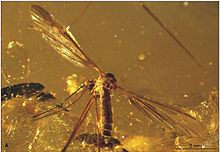Elephantomyia longirostris
| Elephantomyia longirostris Temporal range:
| |
|---|---|

| |
| E. (E.) longirostris male | |
| Scientific classification | |
| Domain: | Eukaryota |
| Kingdom: | Animalia |
| Phylum: | Arthropoda |
| Class: | Insecta |
| Order: | Diptera |
| Family: | Limoniidae |
| Genus: | Elephantomyia |
| Species: | †E. longirostris
|
| Binomial name | |
| †Elephantomyia longirostris (Loew, 1850)
| |
| Synonyms | |
| |
Elephantomyia (Elephantomyia) longirostris is an
History and classification
Elephantomyia (Elephantomyia) longirostris is known from the
E. longirostris is one of six crane fly species in the genus Elephantomyia described from the Baltic amber, the others being E. baltica, E. bozenae, E. brevipalpa, E. irinae, and E. pulchella.[2] All six species are placed into the Elephantomyia subgenus Elephantomyia based on the lack of tibial spurs and by several aspects of the wing morphology.
The fossil was first studied by entomologist Hermann Loew of the Germany, with his type description of the new species being published in 1851 as Toxorhina longirostris, though he published the nomen nudum name a year earlier. The species was moved to the genus Limnobiorhynchus in 1860 by Carl Robert Osten-Sacken, and later moved by Osten-Sacken again, this time to the genus Elephantomyia. The fossils were reexamined and the species redescribed in 2015 by paleoentomologist Iwona Kania of the University of Rzeszów, who examined the holotype and the ten additional specimens. Kania noted that two of the specimens Loew had placed into the species did not match the type description or redescription well, each having a notably short rostrom. Further study of the two was suggested to clarify the species and genus they belong to.[2]
Description
The E. longirostris type specimen and nine of the additional specimens are preserved males, while the eleventh specimen is a female. The body length ranges from approximately 3.00–4.91 mm (0.118–0.193 in) long, not including the
References
- ^ .
- ^ PMID 25706127.
External links
 Media related to Elephantomyia longirostris at Wikimedia Commons
Media related to Elephantomyia longirostris at Wikimedia Commons
